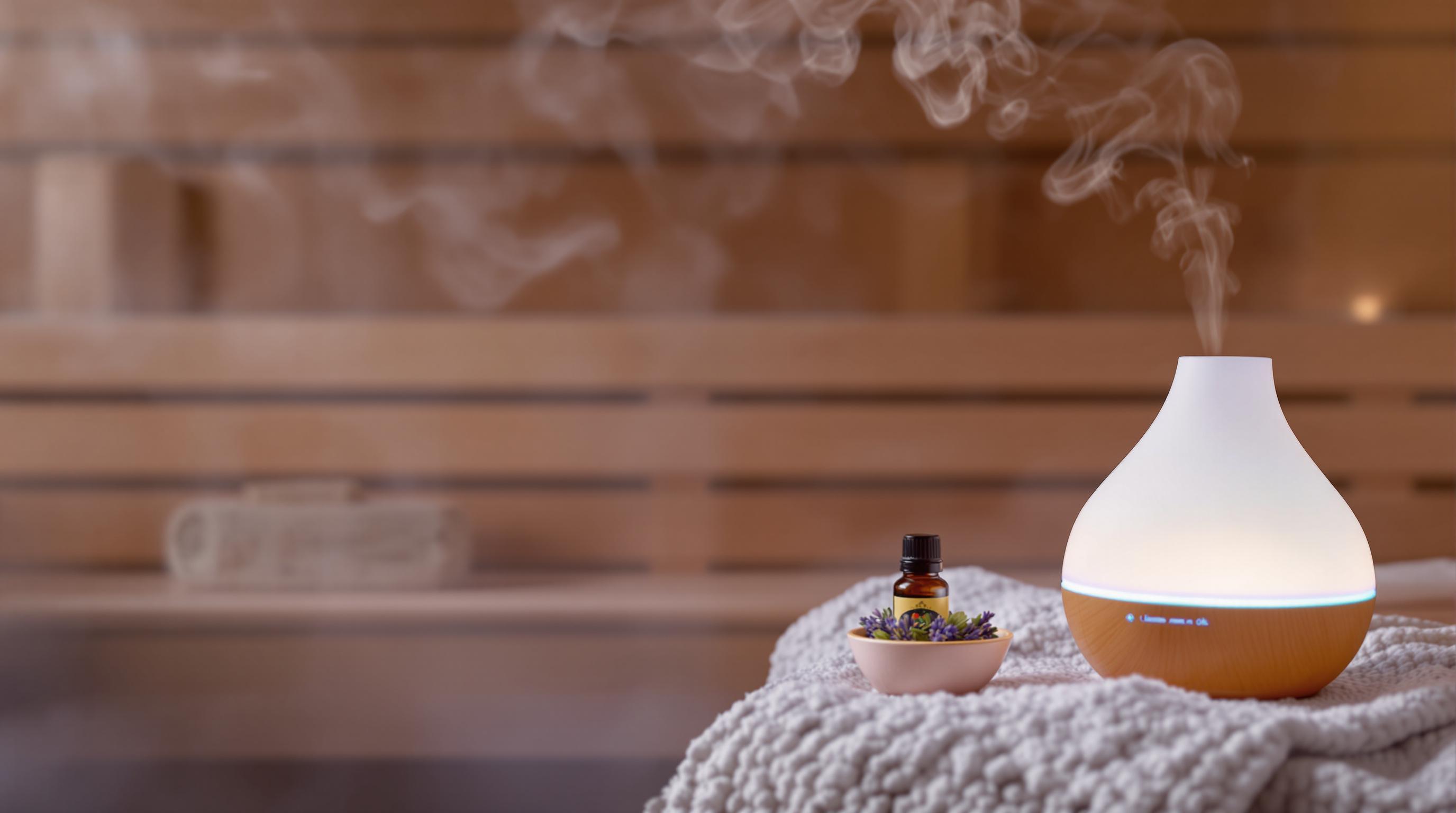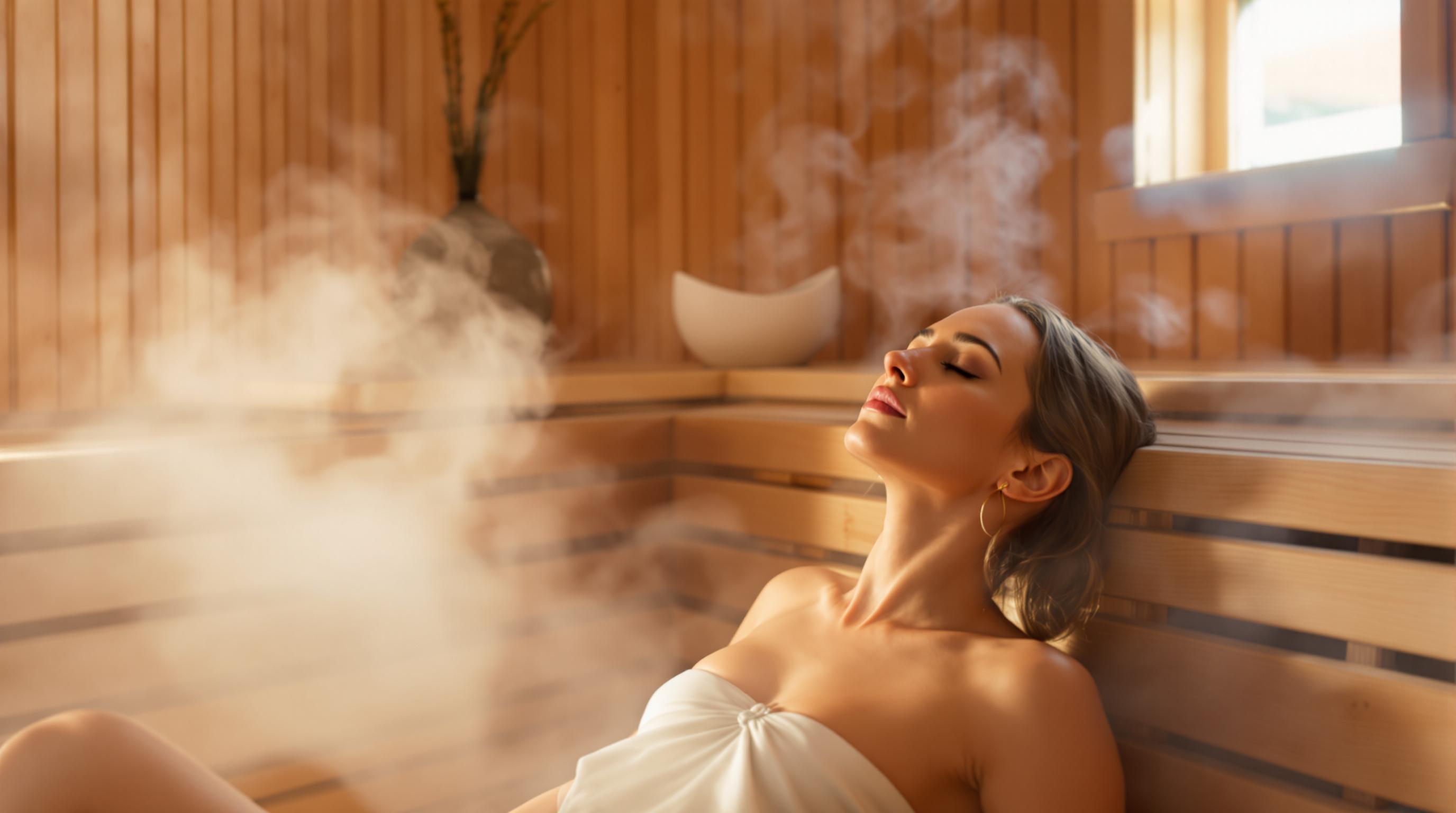When preparing for a sauna, what you wear (or don’t wear) can make or break your experience. The key is choosing lightweight, breathable options that allow your body to sweat naturally while staying safe and comfortable. Here’s a quick guide:
- Cotton towels: A classic choice for all sauna types. They’re breathable, absorb sweat, and provide coverage.
- Swimsuits: Opt for simple, heat-resistant designs without metal or underwire.
- Loose cotton clothing: Great for those who want more coverage. Avoid synthetic fabrics that trap heat.
- Barefoot or wooden sandals: Let your feet breathe.
Avoid metal jewelry - it heats up quickly and can cause burns. Stick to natural fabrics like cotton, linen, or bamboo to stay comfortable and safe. Whether it’s a dry sauna, infrared sauna, or steam room, the right attire ensures a better experience.
What to Wear in a Sauna. A Guide to Sauna Etiquette
Clothing Choices for Different Sauna Types
Choosing the right clothing for a sauna isn't just about comfort - it's also about adapting to the specific temperature and humidity levels of each type. Here's a breakdown of what works best for each sauna environment.
Traditional Saunas
Traditional Finnish saunas are known for their high heat (160°F–200°F) and low humidity (10%–20%). This dry heat environment calls for clothing that helps you stay cool and allows sweat to evaporate naturally.
- Cotton towels are a classic option. Wrapping a large cotton towel around your body provides coverage while letting you perspire freely.
- Swimsuits made from natural fibers or heat-resistant synthetics are another good choice. Go for simple designs without metal clasps or underwire, as these can heat up and cause discomfort.
- Loose cotton clothing, like lightweight shorts or a t-shirt, can also work. Just make sure the fabric is breathable and doesn’t trap heat.
Infrared Saunas
Infrared saunas operate at lower temperatures (120°F–150°F) and use infrared light to heat your body directly. Because of this, less clothing is often better to maximize the benefits.
- Swimsuits or underwear are ideal since they allow the infrared rays to reach more of your skin. Minimal coverage ensures you’re getting the full effect of the heat therapy.
- Thin cotton garments can be worn if you prefer more coverage, but keep in mind that clothing can block some of the infrared rays. If you opt for clothing, stick to lightweight, natural fabrics.
The lower temperatures in infrared saunas make them more flexible in terms of attire, but exposing as much skin as possible is key to reaping the full benefits.
Steam Saunas
Steam rooms are all about high humidity - temperatures range from 100°F to 120°F, with humidity levels hovering near 100%. This constant moisture requires clothing that can handle damp conditions without becoming uncomfortable.
- Cotton towels are a top choice here as well. They absorb moisture effectively, stay comfortable against wet skin, and allow your body to cool naturally.
- Loose cotton clothing, like shorts or a tank top, works well in steam saunas. The loose fit promotes air circulation and prevents moisture from getting trapped against your skin.
- Quick-drying fabrics designed for wet environments can also be an option, but natural cotton is often preferred for its breathability and moisture-wicking properties.
Each sauna type has its own unique environment, so choosing the right clothing can make all the difference in your experience. Whether it’s a towel, swimsuit, or lightweight cotton outfit, the key is to prioritize comfort and functionality.
Basic Rules for Sauna Clothing
Making smart clothing choices can significantly enhance your sauna experience. From fabric selection to accessories, the right attire ensures comfort and safety while maximizing the benefits of your session. Here’s a guide to help you prepare for any type of sauna.
Choose Natural, Breathable Fabrics
When it comes to sauna-friendly fabrics, natural fibers are the way to go. They’re comfortable, breathable, and handle high temperatures better than synthetics.
- Cotton is a top choice. It absorbs moisture effectively and allows air to circulate, keeping you comfortable even as the temperature soars to 200°F. Plus, it avoids the sticky discomfort that synthetic fabrics can cause.
- Linen is another excellent option. Its loose weave promotes airflow, making it ideal for extended sessions. As a bonus, linen softens over time, becoming even more comfortable as it absorbs moisture.
- Bamboo fabric is naturally antimicrobial, which helps reduce odors. It’s also softer than traditional cotton and excels at wicking away moisture, making it a great pick for humid environments like steam rooms.
Avoid synthetic materials like polyester, nylon, or spandex. These fabrics trap heat, can stick to your skin, and may even cause irritation or burns in extreme heat.
Wear Minimal, Lightweight Clothing
When it comes to sauna attire, less is more. The goal is to allow your body to cool naturally while still enjoying the therapeutic effects of the heat.
- A simple cotton towel is a perfect choice. It provides coverage while remaining breathable. Opt for a towel that’s large enough to wrap around your body but not so thick that it becomes heavy when damp.
- If you prefer swimwear, go for natural-fiber designs without underwire, padding, or metal hardware. These features can become uncomfortable as the heat rises. For women, one-piece suits work well, while basic trunks are ideal for men.
- For those seeking more coverage, loose cotton shorts and a tank top are great alternatives. Just make sure they’re relaxed enough to allow airflow.
Sauna Hats and Footwear Options
Accessories can play a key role in protecting sensitive areas like your head and feet during a sauna session.
- Sauna hats might seem unusual, but they’re incredibly practical. Your head is particularly sensitive to heat, and a proper sauna hat - usually made from 100% wool felt - provides insulation, even when damp. These hats are especially helpful in traditional saunas where temperatures can exceed 180°F.
- Barefoot is best in most saunas, as it allows your feet to breathe and regulate temperature naturally. Plus, clean feet show respect for the shared space.
- In facilities like gyms or spas, where walking between areas is common, rubber flip-flops or wooden sauna sandals are acceptable. Wooden clogs, designed specifically for saunas, resist moisture and stay cool while allowing air circulation.
Your clothing choices directly affect your comfort and safety in the sauna. When unsure, stick to natural, simple options that let your body adjust naturally to the heat.
sbb-itb-3953eb0
Items to Avoid in Saunas
Metal Jewelry and Accessories
When preparing for a sauna session, it’s important to leave metal jewelry and smart accessories behind. Here’s why: metal heats up quickly in sauna temperatures - whether it’s a traditional sauna (150–175°F) or an infrared one (120–130°F). This can lead to burns, discomfort, and even damage to electronic devices if the heat surpasses their safe limits.
For instance, necklaces that rest directly on your skin can transfer heat, causing irritation. Other metal items might tarnish, warp, or even get lost in the mix of heat and sweat. Even metals like pure gold, while resistant to tarnishing, can conduct enough heat to feel uncomfortable. It’s best to keep these items out of the sauna to ensure a safer and more enjoyable experience.
Key Points to Remember
What you wear - or don’t wear - during a sauna session can make a big difference in your comfort, safety, and overall experience. Here’s how to get it right.
Choose natural, breathable fabrics like cotton, linen, or bamboo. These materials allow your skin to sweat freely, which is key for detoxification. Whether you prefer a lightweight swimsuit, a simple towel wrap, or going nude in private settings, the goal is to let your body breathe and sweat naturally.
Avoid synthetic fabrics at all costs. They can trap heat and moisture, making you uncomfortable and even increasing the risk of overheating or skin irritation. And don’t forget to remove all metal accessories - rings, necklaces, and watches can heat up and cause burns.
Another must-have? A large, absorbent towel. It’s not just for modesty - it helps maintain hygiene and serves as a barrier between your skin and hot surfaces.
FAQs
Why should you avoid wearing synthetic fabrics in a sauna?
When it comes to sauna attire, synthetic fabrics like polyester or nylon are best avoided. These materials tend to trap heat and moisture, making it harder for your skin to breathe. This can lead to discomfort, overheating, and even increase the chances of dehydration or heat exhaustion.
Another concern with synthetic fabrics is that they may release harmful chemicals when exposed to the sauna's high temperatures, which could pose potential health risks. To stay comfortable and safe, opt for natural, breathable fabrics like cotton. Alternatively, a simple towel works perfectly to cover yourself while allowing your skin to breathe.
Does the type of sauna affect what you should wear?
When it comes to saunas, the type you’re using can definitely impact what you should wear. In traditional and infrared saunas, lightweight and breathable materials like cotton or linen work best. These fabrics let your skin breathe and sweat comfortably. On the other hand, steam rooms call for minimal clothing - think a towel or a swimsuit - since the high humidity can make most fabrics feel sticky or uncomfortable.
No matter the setting, focus on comfort, breathability, and hygiene. Steer clear of heavy or tight clothing, and stick to options that let your body sweat and cool off naturally.
What is a sauna hat, and why should you use one?
A sauna hat is a handy accessory designed to shield your scalp and hair from intense heat while helping to maintain a balanced body temperature. By keeping your head cool, it lets you stay comfortable and extend your time in the sauna for a more relaxing experience.
These hats are especially practical in high-temperature environments, such as traditional or infrared saunas, where the heat can become overwhelming. They’re particularly helpful for people with sensitive scalps, fine or thinning hair, or anyone looking to avoid discomfort caused by excessive heat during their sauna sessions.


